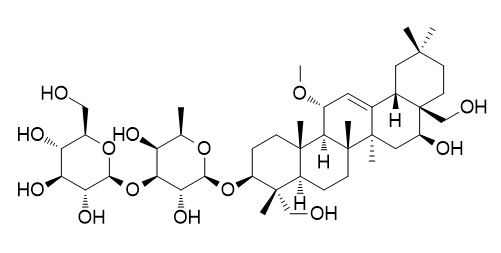Saikosaponin B3
Saikosaponin B3 shows some analgesic effect.
Inquire / Order:
manager@chemfaces.com
Technical Inquiries:
service@chemfaces.com
Tel:
+86-27-84237783
Fax:
+86-27-84254680
Address:
1 Building, No. 83, CheCheng Rd., Wuhan Economic and Technological Development Zone, Wuhan, Hubei 430056, PRC
Providing storage is as stated on the product vial and the vial is kept tightly sealed, the product can be stored for up to
24 months(2-8C).
Wherever possible, you should prepare and use solutions on the same day. However, if you need to make up stock solutions in advance, we recommend that you store the solution as aliquots in tightly sealed vials at -20C. Generally, these will be useable for up to two weeks. Before use, and prior to opening the vial we recommend that you allow your product to equilibrate to room temperature for at least 1 hour.
Need more advice on solubility, usage and handling? Please email to: service@chemfaces.com
The packaging of the product may have turned upside down during transportation, resulting in the natural compounds adhering to the neck or cap of the vial. take the vial out of its packaging and gently shake to let the compounds fall to the bottom of the vial. for liquid products, centrifuge at 200-500 RPM to gather the liquid at the bottom of the vial. try to avoid loss or contamination during handling.
Toxicol Rep.2021, 8:1131-1142.
Nutrients2022, 14(14)2929
Int J Mol Sci.2023, 24(17):13230.
Evid Based Complement Alternat Med.2021, 2021:5023536.
Int J Mol Sci.2018, 19(9):E2825
Food Structure2023, 36:100324.
Patanjali Research Foundation2024, ssrn.4807357
Front Pharmacol.2018, 9:756
Int Immunopharmacol.2024, 141:112906.
J Pharm Biomed Anal.2021, 196:113931.
Related and Featured Products
Molecules. 2014 Dec 4;19(12):20340-9.
Saikosaponin D isolated from Bupleurum falcatum inhibits selectin-mediated cell adhesion.[Pubmed:
25486247]
Three saikosaponins were isolated from the MeOH extract of the roots of Bupleurum falcatum L.: Saikosaponin B3 (1);saikosaponin B4 (2); and saikosaponin D (3).
METHODS AND RESULTS:
Of the three, compound 3 inhibited the interaction of selectins (E, L, and P) and THP-1 cells with IC50 values of 1.8, 3.0 and 4.3 μM, respectively. Also, the aglycone structure 4 of compound 3 showed moderate inhibitory activity on L-selectin-mediated cell adhesion.
CONCLUSIONS:
From these results, we suspect that compound 3 isolated from Bupleurum falcatum roots would be a good candidate for therapeutic strategies to treat inflammation.
Journal of pharmacobio-dynamics, 1980, 3(6):269.
Analgesic and other pharmacologic actions of saikosaponin in repeated cold stressed (SART stressed) animals[Reference:
WebLink]
The pharmacological actions of 7 pure Saikosaponins (a, b1, b2, b3, b4, c and d), the components of Saiko, which plays an important role in Oriental medicine, were studied with special attention to the analgesic effect in repeated cold stressed (SART stressed) mice.
METHODS AND RESULTS:
Single administration of 10 mg/kg of Saikosaponin (SS) in normal mice gave no analgesic effect, but the analgesic effect of b2 and c was great in SART stressed mice, and some analgesic effect was noted with Saikosaponin a, Saikosaponin b1, and Saikosaponin B3 in SART stressed mice. Administration of 5 mg/kg/day of SS for 5 days in SART stressed mice gave an intense analgesic effect with b2 and c, and similar administration of a, b1, b3 and b4 also gave some analgesic effect. The inhibition of the body weight increase in SART stressed mice was counteracted in a dose-dependent manner by administration of 2.5-10 mg/kg/day of SSb2 and c for 5 consecutive days, but similar administration of d augmented the inhibition of body weight. The effect of administration of 5 mg/kg/day of SS for 5 days on the decrease of ACh-response in isolated duodenum from SART stressed mice, which were considered to be in partial vagotonia in small intestine, was studied. While Saikosaponin c, Saikosaponin b1, b2, Saikosaponin B3, Saikosaponin a and Saikosaponin b4 were inhibitory, d was entirely ineffective. The effect of administration of SS on the increase of the ACh-response in isolated duodenum from mice stressed by restraint and water immersion, which were considered to be in partial sympathicotonia in small intestine, was also studied. An inhibitory effect was seen with d, which had been without effect in the specimen from SART stressed mice, while no effect of b2, c and a was noted, despite the positive effect in SART stressed mice. Three kinds of SS effects were distinguished, a central stimulating effect, a central inhibitory effect and a negative effect, based on the hypnotic effect on combined use with pentobarbital, result of measurement of motor activities in open field test in normal mice and experiment on electric resistance of the skin by GSR in SART stressed rats.
CONCLUSIONS:
According to the above results, particularly effects on the change of ACh-response in isolated duodenum, a classification of the action of SS was attempted.



